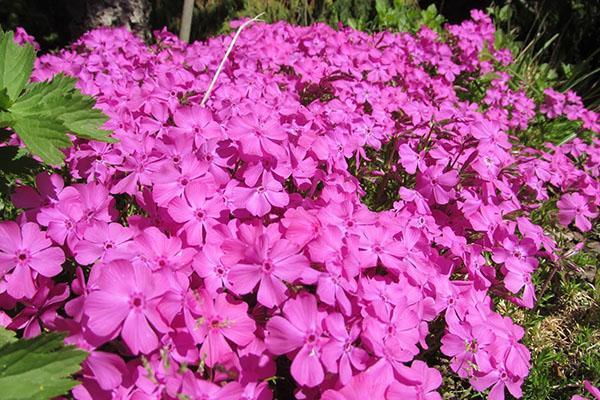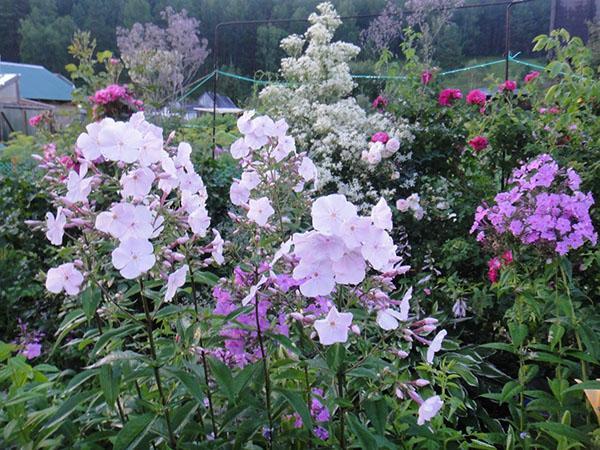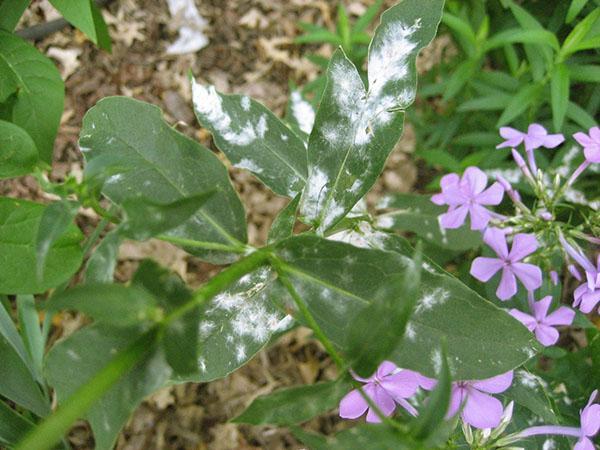What phloxes are sick with and how to treat plants
 These flowers are found in almost every flower bed. Therefore, the question: what phlox is sick with and how to treat these flowers is always relevant. The most common reason that they do not develop and disappear is their disease or damage by insect pests. It can be a viral, fungal, or mycoplasma infection. They all spread very quickly. Of the insects, plants most often infect nematodes; caterpillars of butterflies and slugs love them. Next, let's look at phlox diseases with photos and their treatment.
These flowers are found in almost every flower bed. Therefore, the question: what phlox is sick with and how to treat these flowers is always relevant. The most common reason that they do not develop and disappear is their disease or damage by insect pests. It can be a viral, fungal, or mycoplasma infection. They all spread very quickly. Of the insects, plants most often infect nematodes; caterpillars of butterflies and slugs love them. Next, let's look at phlox diseases with photos and their treatment.
Read also the article: diseases of cucumbers with photos.
Why do flowers get sick?

It is very important to disinfect garden tools that can transmit infection. This will prevent diseases.
Also, improper care can be the cause of death:
- inadequate watering;
- transplanting in summer or late spring;
- growing on too acidic soil;
- using too cold water for irrigation in the heat;
- untimely thinning of plantings.
What do phloxes suffer from and how to treat powdery mildew?
 This disease affects plant leaves only in hot weather with low air humidity. Flowers are actively infected in the second half of summer. The lower tiers suffer first, then the disease spreads to the stem and upper foliage. It is caused by a fungus. Treatment of a disease such as powdery mildew, Phlox is quite laborious.
This disease affects plant leaves only in hot weather with low air humidity. Flowers are actively infected in the second half of summer. The lower tiers suffer first, then the disease spreads to the stem and upper foliage. It is caused by a fungus. Treatment of a disease such as powdery mildew, Phlox is quite laborious.
The best way to fight this infection is through preventive treatment. To do this, from the beginning of summer, flowers must be periodically disinfected with copper-based products, Topaz or any other fungicide. A good result is given by spraying with a solution of furacillin, prepared at the rate of 20 tablets per 10 liters of water.
Regardless of what phlox is sick with and how to treat these plants, it is necessary to process other crops growing in the neighborhood.
Preventive measures against powdery mildew are:
- regular replanting of bushes (every 4 years);
- thinning the stems for better ventilation;
- digging up the earth;
- timely removal of affected leaves and stems and burning them;
- growing varieties that are more resistant to diseases.
If the disease has struck the plants, do not despair. There are many options than to treat phlox for powdery mildew.
Disinfection can be carried out:
- any copper-containing preparation (for example, vitriol);
- a mixture of vitriol (20g) and soap (150g), dissolved in 10 liters of water;
- soda (50g) with soap (50g), dosage also per 10 liters of water;
- infusion of ash (10 water and 3 kg of ash).
Spraying is carried out several times at weekly intervals. After flowering, phloxes are cut off and processed again. Good results are obtained with the use of Topaz, Topsin or Skor with a break of 10 days. It is also possible to spray with these agents for the prevention of diseases throughout the entire growing season of the plant.
Why do the leaves turn yellow?
 If you are looking for why phlox leaves turn yellow, it is possible that the flowers were struck by "jaundice" - a mycoplasma disease caused by pathogenic microorganisms. Additional signs of the disease are dwarf flowers and leaf deformation. The infection is carried by leafhoppers, so it spreads very quickly. More than 200 plant species are sick with jaundice. It is easy to "catch" such an infection. This insidious disease has a very long incubation period - up to two months. Therefore, it may appear in the next phlox flowering season. Old specimens get sick much more often than young ones.
If you are looking for why phlox leaves turn yellow, it is possible that the flowers were struck by "jaundice" - a mycoplasma disease caused by pathogenic microorganisms. Additional signs of the disease are dwarf flowers and leaf deformation. The infection is carried by leafhoppers, so it spreads very quickly. More than 200 plant species are sick with jaundice. It is easy to "catch" such an infection. This insidious disease has a very long incubation period - up to two months. Therefore, it may appear in the next phlox flowering season. Old specimens get sick much more often than young ones.
Fight jaundice by taking the following measures:
- the bushes are systematically thinned out, they are transplanted every 3-4 years;
- in June, for prevention purposes, they are treated with Fundazol or Tsineb;
- strongly yellowed plants are destroyed.
White bloom on phlox
 Novice gardeners perceive any white bloom on the leaves as powdery mildew. But under it often "disguises" peronosporosis. Another name is downy mildew. Its difference is that it develops on plants exclusively at high humidity and lower temperatures. Downy mildew infects phlox in late summer and early autumn. Dense planting and the presence of weeds in the beds contribute to the spread of infection. It covers the plates with a thin white coating, because of this they cannot carry out photosynthesis. The leaves curl and gradually die off.
Novice gardeners perceive any white bloom on the leaves as powdery mildew. But under it often "disguises" peronosporosis. Another name is downy mildew. Its difference is that it develops on plants exclusively at high humidity and lower temperatures. Downy mildew infects phlox in late summer and early autumn. Dense planting and the presence of weeds in the beds contribute to the spread of infection. It covers the plates with a thin white coating, because of this they cannot carry out photosynthesis. The leaves curl and gradually die off.
How to treat white plaque on phlox:
- treat all the bushes with preparations based on copper, Bordeaux liquid, Topaz, Hom;
- cut off the affected leaves and burn them;
- from the beginning of summer every two weeks to spray the plants for prevention with a solution of copper or pollinate with sulfur at intervals of 10 days.
Both false and true powdery mildew affects flowers from the bottom up. Therefore, it is important to regularly inspect the lower tiers of plantings.
Filamentous and fern-like leaves
 These symptoms are caused by a viral flower disease. They are the most difficult to treat. Plants with such lesions are very difficult to save.
These symptoms are caused by a viral flower disease. They are the most difficult to treat. Plants with such lesions are very difficult to save.
When phlox is filiform, their shoots become fragile, the bushes grow very low, they do not bloom. The leaves are narrow, filiform, often with wavy edges. In the second case, phloxes resemble a fern: very small leaves appear on them, attached to the central vein. Both types of deformation of the plates lead to the fact that they cannot fully perform their functions. The plant does not develop well.
There is no effective method of treating the filamentous and fern-like leaves. Affected specimens must be dug up and destroyed, and the soil must be treated with formalin or solution of copper sulfate. Affected phlox should not be cut.
Viruses are carried by nematodes, therefore pest control is one of the effective measures for the prevention of viral diseases of phlox. Effective drugs are Carbation, Chlorpikrim, Nemagon. It is also recommended to disinfect the soil before planting plants with Akarin or Fitoverm. It is favorable to plant nasturtium next to phlox beds. It scares off nematodes.
It is difficult to treat phlox, like other plants. Therefore, in order not to look for what phloxes are sick with and how to cure them from any damage, it is better to prevent the appearance of diseases in advance. And for this you should adhere to the correct care of flowers.
Read the article: onions turn yellow and what to do?